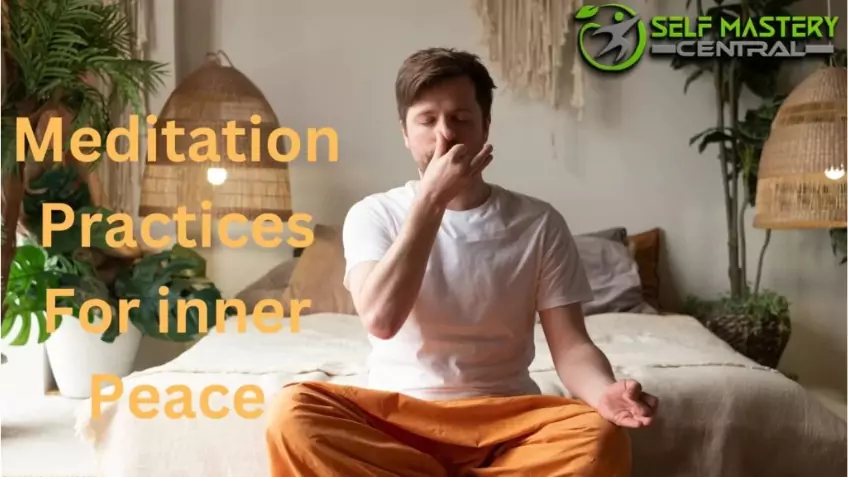Mastering Meditation practices for inner peace
Easy meditation techniques can be an effective tool in the search for inner peace. These methods provide a clear route to peace without requiring intricacy or prolonged training. You can feel a deep feeling of balance and tranquility by adding these simple techniques into your everyday routine.
In this article, we’ll explore some excellent meditation practices that can help you achieve a state of inner tranquility. No need to worry if you’re new to Meditation; we’ll guide you through step by step. Learn simple meditation techniques that can assist you in achieving the desired inner serenity.
What is Meditation? What are the Best Meditation Practices for Inner Peace?
Training the mind to cultivate a state of focused attention, inner calm, and heightened awareness is the practice of Meditation. It is frequently used to promote spiritual development, self-reflection, and relaxation. Because of its many psychological, emotional, and physical advantages, Meditation is practiced in secular settings despite its historical roots in religious and spiritual traditions.

The goal of Meditation is to observe thoughts, emotions, and sensations as they arise without judgment or attachment rather than to stop thinking or reach a blank mind forcefully. A more profound comprehension of the mind and a change in how one interacts with ideas and experiences are made possible by this non-reactive awareness.
From sitting or lying down to walking or moving Meditation, there are many different ways and places to practice Meditation. It can be practiced alone or in a group, and there are options for using apps and recordings for Meditation as well as receiving guidance from qualified instructors.
Why should you start Meditation?
For your general health and well-being, there are many reasons why you should begin a meditation practice.

The reasons why you should start Meditation:
· Stress reduction and relaxation
· Improved mental clarity and focus
· Enhanced emotional well-being
· Increased self-awareness
· Better management of anxiety and depression symptoms
· Improved resilience and ability to cope with challenges
· Enhanced creativity and problem-solving abilities
· Improved sleep quality
· Increased compassion and empathy towards self and others
· Cultivation of a sense of inner peace and contentment
· Promotion of physical well-being and immune system function
· Potential reduction in blood pressure and heart rate
· Integration of mindfulness into daily life
· Provides an opportunity for self-reflection and personal growth
· Can be a spiritual practice for those seeking a deeper connection with themselves or a higher power
Types of Meditation : Top 8 Meditation Techniques for Inner Peace
There are various types of meditation practices, each with its unique approach and focus. Here are some popular types of Meditation:

1. Mindfulness Meditation:
In mindfulness meditation, the primary focus is on being fully present in the current moment and observing thoughts, emotions, and bodily sensations without judgment.It involves bringing attention to the breath, body sensations, or external stimuli and gently redirecting the focus back whenever the mind wanders.
2. Loving-Kindness Meditation (Metta Meditation):
Loving-kindness Meditation cultivates feelings of love, compassion, and goodwill towards oneself and others.It involves silently repeating phrases or well-wishes such as “May I be happy, may you be safe, may all beings be peaceful.”
3. Transcendental Meditation (TM):
Transcendental Meditation is a technique where practitioners repeat a mantra silently to achieve a state of deep relaxation and inner peace. It involves sitting comfortably with eyes closed and allowing the mind to settle and transcend everyday thinking.
4. Guided Visualization:
Guided visualization meditation uses mental imagery to create a specific experience or journey. Practitioners listen to a guided meditation recording or a teacher’s instructions, visualizing scenes, places, or positive outcomes.
5. Body Scan Meditation:
Body scan meditation involves systematically bringing awareness to different parts of the body. Practitioners focus on sensations, tensions, or areas of relaxation, promoting body awareness and relaxation.
6. Zen Meditation (Zazen):
Zen meditation is a traditional Buddhist practice that emphasizes sitting in a specific posture and observing the breath and mind. It involves maintaining an upright posture, focusing on the breath, and letting go of thoughts and distractions.
7. Vipassana Meditation:
Vipassana meditation, rooted in Buddhist tradition, involves cultivating insight and mindfulness by observing the breath, bodily sensations, and mental processes. It aims to develop deep self-understanding and wisdom.
8. Kundalini Meditation:
Kundalini meditation combines breathwork, chanting, and physical movements to awaken and channel energy through the body’s energy centers (chakras). It aims to release blocked energy and promote spiritual growth.
How to do Meditation? Discover the Best Meditation Practices for Inner Peace
Here’s a step-by-step guide to help you get started with Meditation:
1. Find a Quiet and Comfortable Space: Choose a quiet space where you won’t be easily disturbed. It could be a dedicated meditation room, a corner of your home, or even a peaceful outdoor spot. Ensure that you have a comfortable seat, such as a cushion or chair, that supports an upright posture.
2. Set a Time Limit: Decide on the duration of your meditation session. If you’re a beginner, start with just a few minutes, gradually increasing the duration as you become more comfortable with the practice.
3. Get into a Comfortable Position: Sit in a cross-legged position on a cushion or chair, keeping your spine straight but relaxed. Alternatively, you can also choose to lie down if that is more suitable for you. Find a position that allows you to be alert and at ease simultaneously.
4. Set an Intention: Before you begin, take a moment to set a clear intention for your Meditation. It could be to cultivate calmness, find inner peace, or be present in the moment. This intention will guide your practice.
5. Focus on Your Breath: Close your eyes or keep them softly focused on a spot in front of you. Start by taking a few deep breaths, and then allow your breath to return to its natural rhythm. Please direct your attention to the sensation of your breath, feeling the inhalation and exhalation as it flows in and out of your body.
6. Notice Your Thoughts: As you focus on your breath, you may notice thoughts arising in your mind. This is normal. Instead of getting caught up in these thoughts, observe them without judgment. Allow them to come and go, gently bringing your attention back to your breath whenever you find yourself getting carried away.
7. Cultivate Present-Moment Awareness: Expand your awareness beyond the breath and bring attention to the present moment. Notice any bodily sensations, sounds, or emotions that arise. Be fully present with whatever arises in your experience, accepting it without attachment or judgment.
8. End with Gratitude: When you’re ready to conclude your Meditation, take a moment to express gratitude for the time you’ve dedicated to your practice. Reflect on the benefits you’ve gained and carry the sense of calm and presence with you into the rest of your day.
How Meditation works?
Meditation is a practice that involves training the mind to focus, redirecting thoughts, and cultivating a state of inner calm and awareness. While the exact mechanisms of how meditation works are still being studied, here are some critical aspects of how Meditation is believed to work:
1. Attention Regulation: Meditation helps improve attention regulation by training the mind to focus on a chosen object of attention, such as the breath or a mantra. With regular practice, individuals become better at sustaining attention and resisting distractions, both during Meditation and in everyday life.
2. Brain Activity and Neuroplasticity: Research suggests that Meditation can induce changes in brain activity and structure. Regular meditation practice has been associated with increased gray matter density in brain regions related to attention, emotional regulation, and self-awareness. It is believed that Meditation can promote neuroplasticity, the brain’s ability to reorganize and form new connections.
3. Stress Reduction: Meditation activates the body’s relaxation response, which counteracts the physiological effects of stress. It can lower cortisol levels (the stress hormone) and reduce heart rate and blood pressure. By consistently practicing Meditation, individuals may experience reduced anxiety and improved overall well-being.
4. Emotional Regulation: Meditation can help individuals develop emotional resilience and regulate their emotions more effectively. By observing thoughts and feelings without judgment during Meditation, individuals become more aware of their mental and emotional states. This awareness allows them to respond to emotions with greater clarity and stability.
5. Self-Awareness and Mindfulness: Meditation cultivates self-awareness and mindfulness, the ability to be fully present and non-judgmentally aware of the present moment. By observing thoughts, sensations, and emotions during Meditation, individuals develop a greater understanding of their inner experiences. This heightened self-awareness can lead to improved self-regulation and a deeper understanding of oneself.
6. Well-being and Quality of Life: Regular meditation practice has been associated with numerous psychological benefits, including increased well-being, improved mood, reduced symptoms of anxiety and depression, and enhanced overall quality of life. By incorporating Meditation into daily life, individuals may experience greater contentment and happiness.
People also asked
Q: How long should I meditate?
A: The duration of Meditation can vary based on personal preference and availability. Starting with just a few minutes a day and gradually increasing the duration is a good approach. Aim for at least 10-15 minutes per session, but even a few minutes of daily practice can be beneficial.
Q: Can Meditation help with anxiety and depression?
A: Yes, Meditation has been shown to help manage and reduce symptoms of anxiety and depression. It promotes relaxation, cultivates mindfulness, and helps develop a more balanced perspective on thoughts and emotions.
Q: Can I meditate lying down?
A: While it’s typically recommended to meditate in a seated position to maintain alertness, you can also meditate lying down. However, be mindful of the tendency to fall asleep in this position. If you find yourself drifting off, it may be better to sit upright.
Q: Can Meditation conflict with my religious or spiritual beliefs?
A: Meditation is a flexible practice that can be adapted to various belief systems, including religious and spiritual ones. It can complement and enhance your existing beliefs and practices. You can choose to incorporate specific intentions or prayers into your Meditation if it aligns with your beliefs.
Q: Is Meditation challenging to learn?
A: Meditation is a skill that becomes easier with practice. While it may be challenging initially to quiet the mind and maintain focus, consistent practice, and patience can lead to significant progress over time. Guided meditations and instruction from experienced teachers can be helpful for beginners.
Q: Can children and teenagers meditate?
A: Yes, Meditation can be beneficial for children and teenagers. There are specific meditation techniques and programs designed for different age groups. It can help improve focus, emotional regulation, and overall well-being in young individuals.
Q: Can I meditate if I have physical limitations or health issues?
A: Absolutely. Meditation is a flexible practice that can be adapted to accommodate physical limitations or health issues. You can modify the posture or choose a meditation technique that suits your abilities. It’s always a good idea to consult with a healthcare professional if you have specific concerns.
Q: Can I meditate if I have a busy mind or find it hard to sit still?
A: Yes, Meditation can be particularly helpful if you have a busy mind or find it challenging to sit still. The practice of Meditation involves observing thoughts without judgment and gently redirecting the focus back to the chosen object of attention. Over time, it can help calm and quiet the mind.
In conclusion
There are several advantages to Meditation for general health and life satisfaction. Stress can be decreased, mental clarity and attention can be improved, emotional well-being can be enhanced, self-awareness can be raised, and inner peace and satisfaction can be fostered.
People from all backgrounds can practice Meditation, and it can be customized to meet each person’s requirements and interests. Meditation is a useful technique for self-care and inner investigation, regardless of your goals—relaxation, personal development, or spiritual connection.
Also Read: Mindful Walking Meditation?






